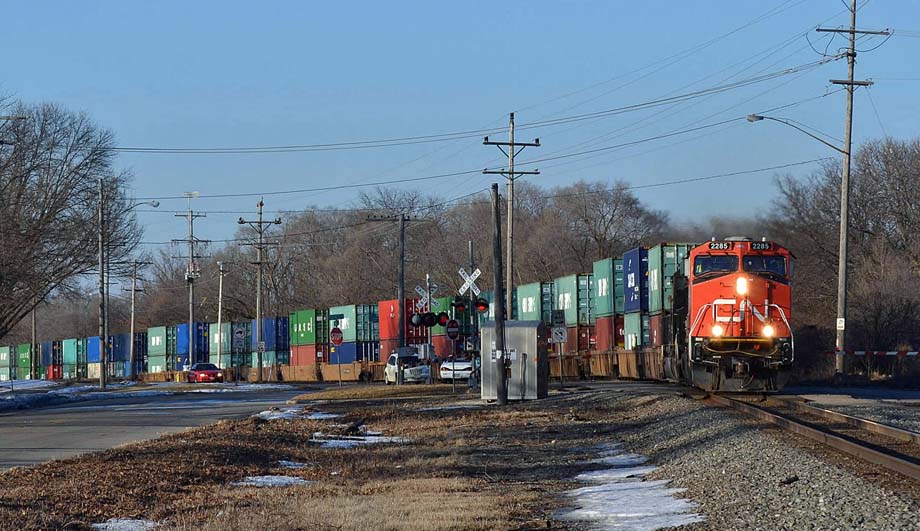
Canada - For more than a decade, British Columbia ports have won market share from U.S. West Coast
ports for containers bound to Chicago and the Midwest, but that long-term trend has reversed in a matter of months due
to the two-week dockworkers strike at Vancouver and Prince Rupert.
The July strike prompted U.S. importers to divert their freight to ports on the U.S. West Coast, particularly in the
Pacific Northwest.
And that freight has not shifted back to the Canadian ports, which has hurt U.S.-bound international intermodal traffic
handled by CN and CPKC, executives said this week.
CN's third-quarter intermodal volume was down 23 percent, while CPKC's was off by 10 percent, due to a combination of a
slowdown in imports as well as the port strike.
"We continue to see a hangover effect from cargo diversions to U.S. gateways," CN Chief Marketing Officer
Doug MacDonald said on the railway's earnings call on Tuesday.
The big winner was the Northwest Seaport Alliance, which includes the ports of Seattle and Tacoma,
Washington.
Import container volume there surged by 62 percent from August to September, measured by TEUs, or 20 foot equivalent
units, the common measure of international containers.
BNSF Railway and Union Pacific serve the Pacific Northwest ports.
Prince Rupert's September import TEU volume, meanwhile, fell 12 percent in September compared to August.
Vancouver import TEU volume was up 2.8 percent from August to September, but that lagged the 10.8 percent TEU gain at
U.S. West Coast ports over the same span.
"Clearly there has recently been a big disconnect between what has been happening in the U.S. PNW and Western
Canada. The recovery from the port strike in July has been slow and incomplete," intermodal analyst Larry Gross
says.
Canada-U.S. cross-border international container volume was down 14 percent in September compared to August, Gross
says, noting that the August volume was nearly down to July levels, which had suffered from the two-week port
strike.
"Was this weakness just a hangover from the port strike? It seems unlikely. It appears that something fundamental
has changed in this market," Gross says.
RailState, a company that tracks North American rail movements using a network of sensors near main lines, noted the
change in CN and CPKC international intermodal traffic.
"International intermodal volume (20 foot and 40 foot containers) decreased in September. The total average daily
volume headed eastbound from the Western Canada ports was down 15.6 percent in September compared to August. It is
important to note that August had somewhat inflated intermodal volume as the railways worked to clear the backlog at
the western ports from the dockworkers' strike in July. CPKC saw a steeper decline in volume, dropping 21 percent in
September compared to a 16 percent drop for CN," RailState said in a blog post.
"I do believe structurally there's been somewhat of a change on the West Coast ports. Just look at our train
lengths and where our import volume is going. It's all domestic Canada and very little volume going into the
U.S.," CPKC Chief Marketing Officer John Brooks said on the railway's earnings call on Wednesday.
Brooks doesn't expect a quick rebound in overall import volume anytime soon, based on conversations CPKC salespeople
have had with steamship customers in Asia and Europe.
It may take congestion at Los Angeles and Long Beach, California, to drive volume back to Vancouver, he
suggested.
"Certainly there's a reason why Vancouver and Prince Rupert have had success. We have port fluidity, we have some
economic advantages," Brooks says.
CN executives say those advantages, which include lower port container fees, faster turn times for container ships, and
favorable exchange rates for the Canadian dollar, ultimately will lure traffic back to Vancouver and Prince
Rupert.
"We think this is a temporary issue. There are some real structural advantages, to Rupert in particular, both
economic and service. We have set Rupert up with a premium container service into U.S. markets, and that kind of
strategy has been working. And when the strike occurred it's that business that started to move to U.S. ports. But that
structural advantage continues. And we're two days faster from China to Chicago than other alternatives," CN CEO
Tracy Robinson said on the earnings call.
CN's customers say the U.S.-bound international traffic will gradually shift back to Vancouver and Prince Rupert over
the next year or so, MacDonald says.
"We think that business is going to come back. We're working with our customers on it. Our call is that it will
come back gradually. We've lost a little confidence in the West Coast ports," Robinson says.
Between 2010 and 2019, container volume at Vancouver and Prince Rupert was up a combined 57 percent as they became
gateways to the U.S., while U.S. West Coast volume was up only 9 percent.
U.S. Pacific Northwest ports were the hardest hit by the shift of volume to British Columbia ports.
Intermodal volume from the Pacific Northwest to the Midwest lost half its share between 2006 and 2019.
One of the factors behind the shift of traffic to Vancouver and Rupert was labor strife at the ports of Los Angeles and
Long Beach, including an eight-day dockworkers strike that began as a lockout in November 2012.
Bill Stephens.
(likely no image with original article)
(usually because it's been seen before)
provisions in Section 29 of the
Canadian Copyright Modernization Act.
